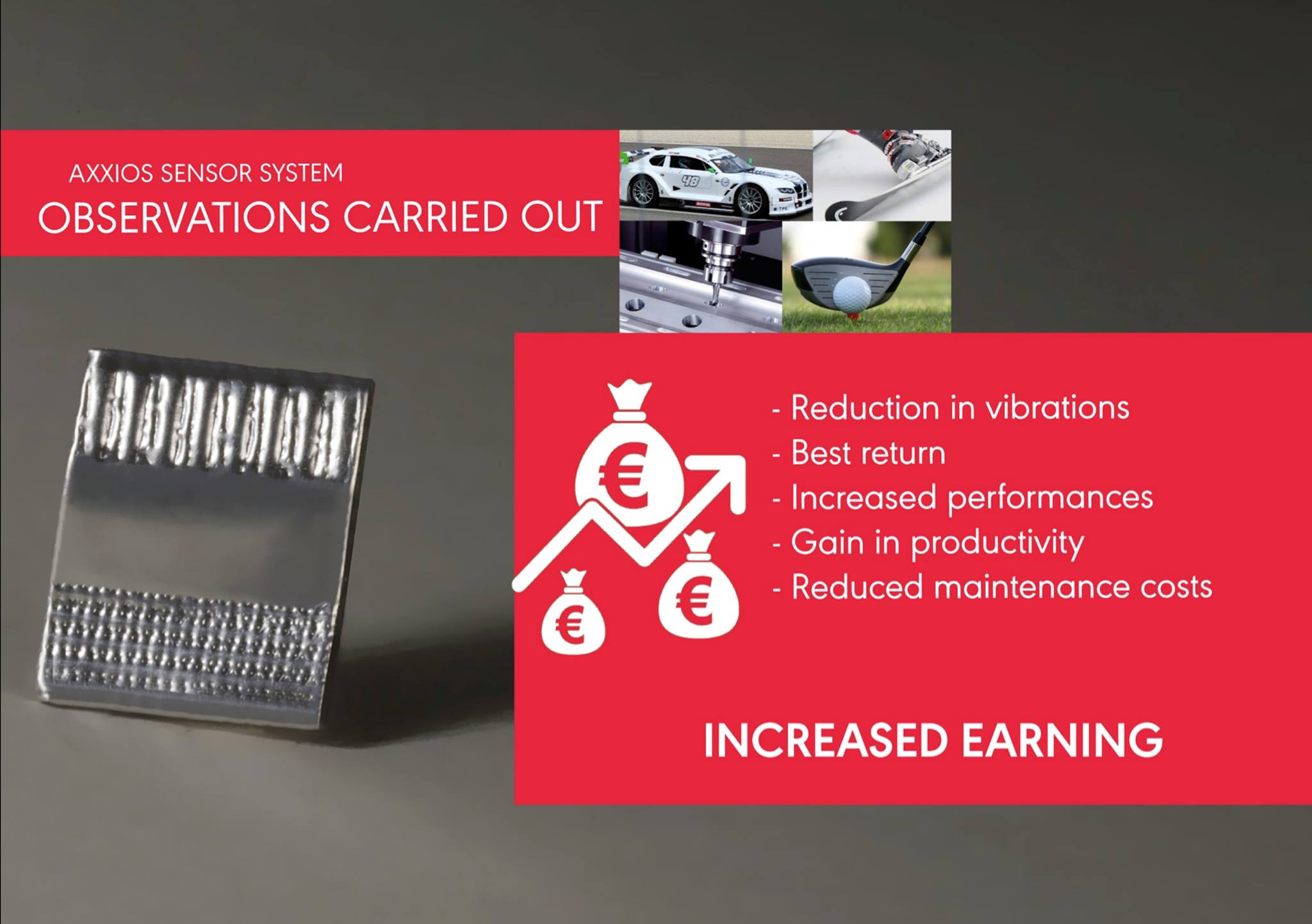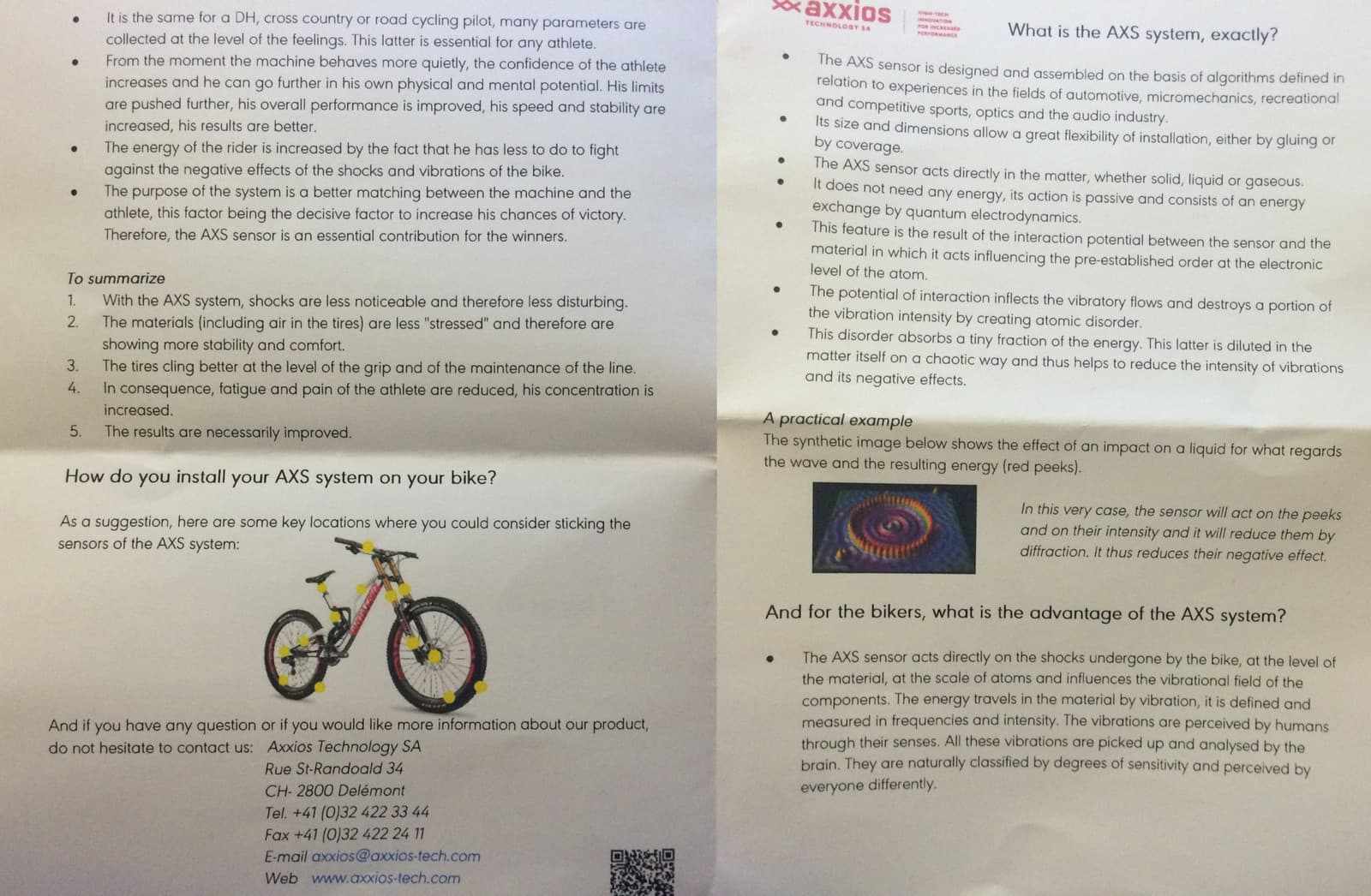You may have seen something knocking around the pits at World Cup Downhill races since last year: tiny silver stickers on bikes, and rubberised black ones on tyre sidewalls, with claims floating around that they make the bikes faster. They’re a so called “sensor system” by a Swiss company named Axxios Technologies. It costs around one thousand Euros per bike and they’re making some very bold claims.
Commencal are the most notable people running it, on their team bikes:
Radon Factory XC Racing has also been talking about it and posting photos. Below are some of Axxios’ claims, followed by some facts to help you make up your own mind.
Radon Factory XC Team have also posted about Axxios’ product (source).
The Claims:
Mainly, Axxios Technology SA talk about vibration damping. In some of the company’s literature, there is talk about how the results can only be measured by “the feelings of the athlete”. If you dig through their website for long enough, you find various other claims, such as that Axxios’ technology can alter the modulus of elasticity for a material by somehow interacting with it through electron fields on an atomic level. Not only that, but the company also claim this is done passively, with no external power source, by a sticker smaller than a postage stamp.
If it’s equipment in a machine shop, or heavy plant machinery, then sticking them onto the machines, they claim, optimises oil flow and prolongs the life of cutting edges as well as consumable parts like hoses. On mountain bikes, Axxios claims these patches create better small bump compliance, reduced rolling resistance, faster acceleration, increased grip, better suspension function, greater stability, more “linear” braking, less need to bleed brakes, “less turbulence in the fork oil cartridge”, less oil emulsion, and lower wheel bearing wear. All from sticking them to different parts of the bike. What can’t these magic foil stickers do?
The Facts:
1. They’ve misrepresented actual science
This is the closest thing we’ve found to a smoking gun, and not only did we recognise it, several physicists we consulted immediately spotted it too. Look at this image:
Image: Don Eigler, IBM Almaden Research CenterIt’s an image of a quantum corral, made by Don Eigler and his team in 1993. Here’s part of their description for it: “The corral is an artificial structure created from 48 iron atoms (the sharp peaks) on a copper surface. The wave patterns in this scanning tunneling microscope image are formed by copper electrons confined by the iron atoms. Don Eigler and colleagues created this structure in 1993 by using the tip of a low-temperature scanning tunneling microscope (STM) to position iron atoms on a copper surface, creating an electron-trapping barrier. This was the first successful attempt at manipulating individual atoms and led to the development of new techniques for nanoscale construction.”
An historic achievement then, but what’s this? You can see it on the leaflets Axxios had at Lenzerheide (source article). Here’s the description Axxios give it:
“The synthetic image below shows the effect of an impact on a liquid for what regards the wave and the resulting energy (red peeks)[sic]. In this very case, the sensor will act on the peeks and on their intensity and it will reduce them by diffraction. It thus reduces their negative effect.”
None of that is true, and this goes well beyond the scope of a possible translation error. Whoever put that leaflet together for them, or at best the source they used, is plagiarising the image and at the very least, mistaken about what it is.
2. They haven’t published any verifiable results
According to the CEO’s LinkedIn profile, the company was founded in 2004 (2015 according to the company profile page, which actually seems to be when they rebranded as “Axxios Technology SA”). However long they’ve existed, they seem to have published nothing repeatable. Nothing is referenced, there is almost no data available, just some wildly mismatched, sometimes unlabelled, low resolution graphs shoved into a presentation. In that context, those graphs are meaningless.
Not only the sensors, but also Axxios branding are visible on this bike.
In the few results Axxios do post, the data is scant and they don’t show any methodology. For instance, these times given for mountain bike descents done with and without their product installed:
Even if this was a well run and controlled experiment, this is a paltry amount of data to get from it. We’d expect to see results like this simply from someone warming up and trying a course twice.It’s on this page (archived version here), and of nine riders listed, seven only give subjective impressions and have no data recorded. The only two that do have data under their names present only four results each, appearing to be split over two different tracks. That is not an adequate data set from which to draw a sure conclusion. As well as that, there’s no detail given on methodology, and without that, we can’t be sure what flaws were or were not present in any study done. For instance, were the trails familiar to the riders or not? Was it always the second run down a trail that was done with the product installed? Was the testing blind, or did the rider know in advance whether the bike had the product installed or not? Were both runs done on the same bike, or different bikes? All of these are factors that could influence results, and none of them are documented or spoken of.

In this video made by a third party, a pro downhill racer talks about how they have twenty or so of these patches on their bike and claims they definitely help. Nearly everything Axxios put out is like this: subjective accounts and claims attempting to sound authoritative and scientific. None of the testing they’ve done seems to be blind testing. Every testimony is from someone who just believes in it, which opens up a possibility that this could be the (entirely realistic, well studied and documented) placebo effect at work.
3. The website is largely word salad
This is particularly the case when it touches on anything that sounds technical. For example: “A number of laws and physical principles are the basis for the AXS System. Here are the most important ones: Coulomb’s law, Elastic modulus (Young), Fermi level. The Couette flow allows to confirm the laminar effect of liquid and gaseous flows”. None of these terms mean anything in the context of Axxios’ text. It would contain an equal amount of information if it just said “this has something to do with matter and energy”. It would make an equal amount of sense if you substituted terms like “dilithium crystals”, “unobtainium” and “sonic screwdriver”. The lack of coherence in what Axxios are saying is a worrying indicator.
Here’s an example:

A Chladni plate. Invented by acoustic pioneer Ernst Chladni in the 18th century, they’re beautiful and you can make one at home. How does it relate to Axxios’ product?

According to this slide, it doesn’t! They just throw out a bold claim about what their product does, then describe an experimental setup with a Chladni plate that bears no relation to the claim or the product. This slide is a non-sequitir, but it does sound very sciency.

4. They list very few employees

The employees and directors they do have appear to have are people with no documented expertise in physics or engineering. Almost none have any technical background – most of them come from sales, marketing or management. Here’s what we found via LinkedIn, business registries, and various search engines:
- CEO Jacques-Alain Lehmann was a ski instructor who has spent time doing business management.
- Isabelle Lehmann seems to be spouse of Jacques-Alain, and has spent much of the past decade running some sort of psychiatric care home with him.
- Philippe Siraut apparently trained in electrical engineering for telecoms applications from 1979 – 1984, but mostly worked in sales since and was only with Axxios during 2016.
- Chantal Baer is listed as Chief Marketing Officer, but in fact runs her own entirely separate branding agency.
- Cyril Graber is a student at a business school.
CTO Pierre Lerch is the only person left with any kind of possible technical background, and he is hard to find. The closest match we can locate is a listing for Pierre Lerch, Professor Emeritus at Ecole Polytechnique Fédérale de Lausanne, and he was born in 1927. If you check the picture of him on their website (archived here), he’s looking pretty good for a 90 year old. So maybe Pierre is someone else, but aside from a 90 year old professor emeritus, we can find no images, references, publications or other online presence for a Pierre Lerch with skills that would be relevant to Axxios’ technological claims.
5. Everything they put out seems to be a sales pitch. For example:

Nearly everything in the pitch these images are taken from starts out with the aesthetics of science, then veers suddenly into ideas of financial gain. Everything else is referred to in simplistic terms, yet not really explained. In whatever field Axxios talk about, they refer to vibrations as bad, and only ever talk about their product reducing them. No mention of resonant frequencies. No mention of industrial processes that utilise vibration. No mention of structures, just materials. No technical explanation, not even a simplified one, just “Vibrations BAD, money GOOD”, over and over again.

6. This leaflet suggests sticking them on your fork stanchions:

7. The technology Axxios claim to be selling has no technological precedent
Their claims imply computing technology that simply does not exist. Anything able to achieve the things they’re claiming in any measurable way, in the ways they’re claiming it works, would have fundamentally changed fields such as rocketry, aviation, computing, demolition and weaponry, and that’s just for a start. Yet, in 13 years, somehow their product hasn’t.
Supposedly the stickers have algorithms in them to define how they interact with matter, but none of Axxios’ literature mentions any programmers or physicists, who would be needed to create those algorithms. It’s completely unclear how the stickers are programmed, or what kind of memory they have inside them. Nor do they elaborate on how anything can process data while powered passively. A chip that could be powered from induction, using amounts of power so small they’re somehow extracted from the atoms it’s stuck to, and is flexible too, is at present science fiction. Nobody else has yet demonstrated technology approaching that, and if Axxios really had invented something so advanced, giant companies like Intel, AMD, ARM, Motorola and Texas Instruments would be fighting to buy them (induction powered chips do exist right now, but they’re much bulkier than whatever Axxios are selling, aren’t flexible, and require an external battery to be stuck down above them).

Anything this revolutionary is generally grounded in decades of academia; yet we can find nothing. Beyond the boundaries of the company there just seems to be vapour. No history, no science, no verifiable results, no connections to higher education or commercial laboratories, no documentation. Just subjective accounts and a mysterious CTO who either leaves no trace online, or is a very old academic and never published this groundbreaking work.
Axxios’ claims suggest that the combined engineering, physics, mathematical and chemical knowledge of Earth’s academia, corporations, space agencies, militaries, startups, and government laboratories have missed something fundamental and simple about the laws of physics – so simple that a small group of marketing and sales people could turn it into a product and start selling it without leaving any research, receipts for R&D, or other forms of evidence behind them.

8. At the level of competition they’re selling this to, margins between winning and not winning can be hundredths of a second
There are a whole host of variables in a World Cup Downhill race, ranging from athletes mental states, to weather and course conditions all the way down any given mountain, which can change drastically over the course of a single event. That many uncontrolled and unmeasurable variables seem to keep a lot of things comfortably unverifiable for Axxios.
9. Axxios don’t seem to have any patents
We’ll point out here that we approached Axxios some weeks ago about this, and they’re yet to respond. There are none registered to Axxios. There are none assigned to CEO Jacques-Alain Lehmann. There are no hits for “quantum electrodynamics” or related terms in the category B64C27/001, which is vibration damping devices. As mentioned above, the only person listed on their site who has any possible technical background is CTO Pierre Lerch, and he’s not registered as the assignee or inventor of any patents either.
10. Axxios ignored all requests for comment or information
Over the past few months, several of us have tried contacting several of the people listed on the Axxios website staff page. We’ve requested information on the product, information on the company, marketing materials, and comment on this story. No responses have been forthcoming.

What We Think
Whilst we can’t confirm or disprove any of Axxios’ claims by any research done without getting our hands on the product itself (and trust us, we have requested Axxios’ product for testing), the burden of proof ultimately doesn’t lie with us. Nothing we’ve said or pointed out in this piece is untrue, and Axxios failed to respond to repeated requests for comment. Digging around the company raises some serious concerns, from non-technical staff, to lack of history, to consistent failure to demonstrate any repeatable results or methodology. All of this should raise some large red flags for pretty much anyone.
Axxios’ assertions about their product remind us of Power Balance, who had to retract their own claims in 2010.

It seems some people might be True Believers™ including mechanics and racers, but we don’t think everyone involved in it is a sucker. Imagine:
- You’re a pro downhill racer. You spend most of your time training and thinking about racing. Someone comes to you and says they have an amazing new technology, which is expensive and promises miraculous results. It weighs nearly nothing and you don’t have to spend your own money on it. You don’t have the time or bandwidth to really check it out, and there seems to be no downside. Would you try it out? Sure.
- You’re a pro racer, and you’re extremely sceptical, but someone on your team believes in this thing and you’re not the one paying for it. So, whatever.
- You’re a pro racer, and your entire team seems to believe in this thing. Do you rock the boat with your scepticism, or do you keep quiet and succumb to peer pressure?
- You’re a manager or mechanic. You’re highly sceptical of this thing, but the rider you support isn’t, and you’re keenly aware of how much help the placebo effect can give someone in achieving anything. That edge could be good for the racer, your career and the sponsors you work for. So do you immediately call bullshit? Maybe not.
We don’t know if that’s the case for anyone racing with it or supporting a racer.
There have been a bunch of writers being very nice and saying they won’t dismiss it until they’ve tried it. Our considered, researched opinion is that in the absence of any concrete proof, we’re happy to dismiss it right now. Unless they’re willing to submit their product to blind testing by a third party, in a controlled environment, then they’ve done nothing to give us any faith in them, and a lot that makes us sceptical.
Legally, outside of clearly marked opinion we have to simply report the facts and say “make your own mind up”. Unless something absolutely amazing is verifiably demonstrated very soon though, we’ve certainly made up ours. But we are happy to be proved wrong.












If only Esther Rantzen still investigated such claims…..
Good on you for calling out utter BS!
Good to see this on here. Nice one STW.
pure entertainment, funniest thing I`ve read for a while. lets all get some little foil stickers stick them all over our bikes and go fast ha ha ha we need more stories like this , excellent!
I have some rather charming snake oil tape you can wrap your entire frame In and it will help you travel into the future once you hit 88mph.
If will also make you more attractive to the opposite sex, the only person on earth to look good in lycra, pay your child support and leave you smelling like fresh linen.
Just £995 per application, hit me up.
P.s
Just ask Dave, he tried it and now he’s rolling in kom’s!
Great article, thanks for helping de-bunk their claims.
Where can I buy these from, the sound ace?
It’s very easy to explain any performance gains seen by athletes *if* they know they are using something that is supposed to increase performance. That’s why real scientific experiments will use double-blind tests.
Well done STW for being so candid. I applaud you.
Nicely written and researched piece to call out these fraudsters!
I remember Geraint Thomas promoting the Power Balance hologram bracelets a few years ago. I lost a lot of respect for him over that.
Normal M.O. of a snake-oil company charging thousands of Euros for their placebo sticker would be to threaten to sue your arse off at this point. Let’s see what happens next.
I’m really embarrassed to say this, but I thought the was a joke when I first saw it a few months ago so I dismissed it as a laugh…..and I’ve been caught out!! 😀
https://youtu.be/gM8vOcxatsI
Complete BS, like you suggest, I think most of those you’ve seen in the circuit have been given out and chucked on cause ‘why not’. Can’t see them actually selling any.
Why are Trading Standards not all over this ?
Will the customers (suckers) get their money back, or will this be seen as a tax on the stupid.
Well done STW for outing myths like this.
Reminds me a lot of the kind of thing aimed at hifi nuts!
Well done STW. Shocking that these products are being promoted in this way. Shades of the old Iraqi bomb detector product that transpired to be utter guff. If you do get a nasty lawyer’s letter drop me a line, I’d be happy to help!
Stickers FTW!
“Give it the beans” stickers were placed on a handful of bikes at Ft William BDS.
Five of them were later podium placed. Factual proof that stickers make you faster…
I’d come to the ‘Snake Oil’ and ‘Placebo’ response about 3/4 of the way through the 1st paragraph.
Mind you I always found I rode faster when I had my ‘I Brake for Cake’ sticker on my old RTS..
I think you may have spent far too much time on this article.
The concept and product barely deserves a single line!
Thanks for the entertainment though 🙂
This reminds of 80s HiFi magazines and the claims of Peter Belt. He sold small stickers that you were meant to put on all your HiFi components. They didn’t work either, despite the scientific claims.
As one moves up the range of mountain bikes and gadgets, one has to pay more and more for smaller and smaller incremental improvements. A £100 bike is not much good, and a £500 bike is very significantly better. A £1000 bike is probably twice as good as a £500 one, but a £3000 bike is not 3 x as good as the £1000 job. The £6000 bike is unlikely to be twice as good as the £3000 one.
To pay £1000 for no objective improvement is the logical conclusion to what we all do anyway. Good luck to them. The lessons learned from this device should perhaps make us think about all the expensive items we spend our money on.
Finally, the idiots who love wasting their money on magic crystals for their hi-fi have a similar product their bike!
Great break down of a bullshit product.